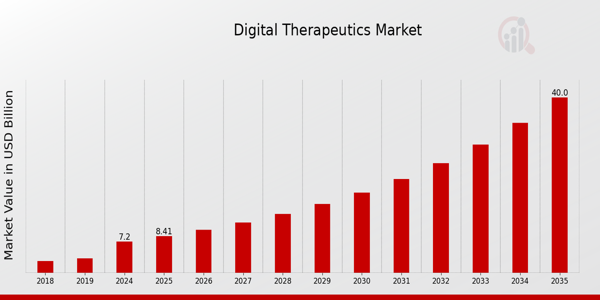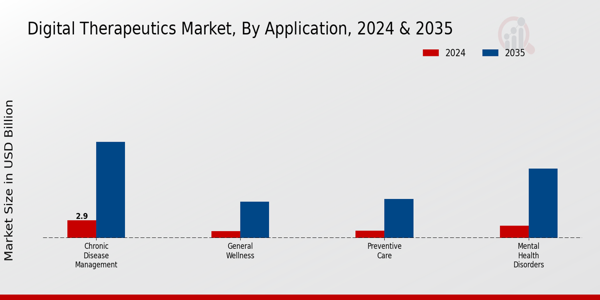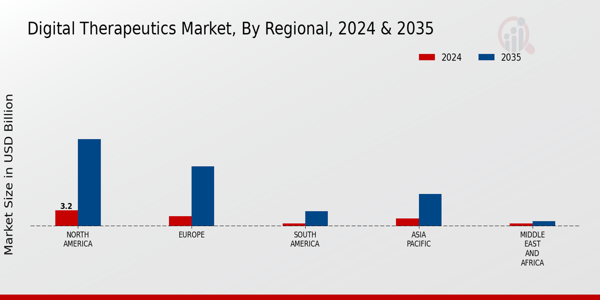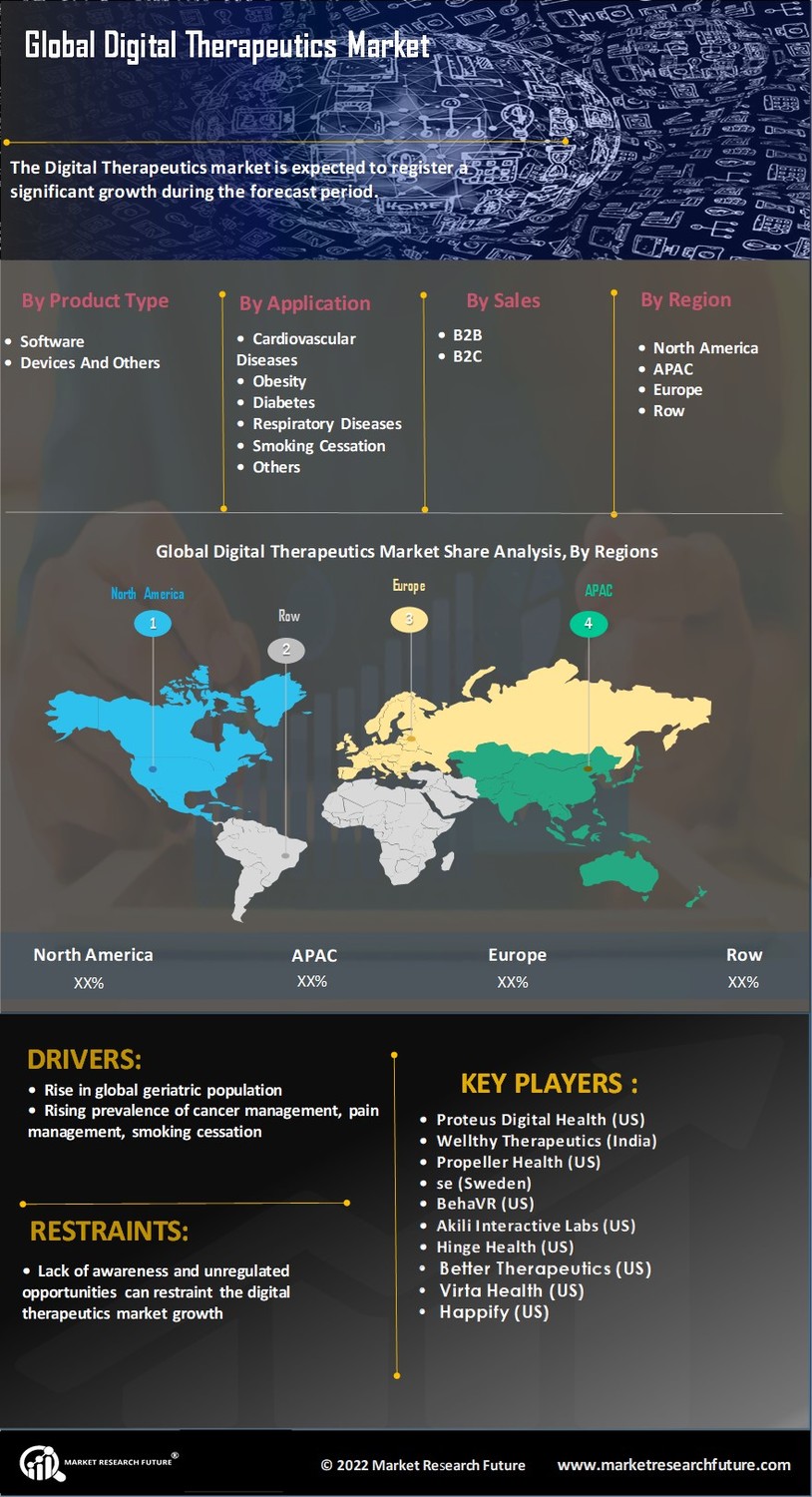-
LIST OF ASSUMPTIONS
-
North America Digital therapeutics (DTx) Market SIZE ESTIMATES & FORECAST, BY APPLICATION, 2019-2035 (USD Billions)
-
North America Digital therapeutics (DTx) Market SIZE ESTIMATES & FORECAST, BY DELIVERY MODE, 2019-2035 (USD Billions)
-
North America Digital therapeutics (DTx) Market SIZE ESTIMATES & FORECAST, BY END USER, 2019-2035 (USD Billions)
-
North America Digital therapeutics (DTx) Market SIZE ESTIMATES & FORECAST, BY THERAPEUTIC AREA, 2019-2035 (USD Billions)
-
North America Digital therapeutics (DTx) Market SIZE ESTIMATES & FORECAST, BY REGIONAL, 2019-2035 (USD Billions)
-
US Digital therapeutics (DTx) Market SIZE ESTIMATES & FORECAST, BY APPLICATION, 2019-2035 (USD Billions)
-
US Digital therapeutics (DTx) Market SIZE ESTIMATES & FORECAST, BY DELIVERY MODE, 2019-2035 (USD Billions)
-
US Digital therapeutics (DTx) Market SIZE ESTIMATES & FORECAST, BY END USER, 2019-2035 (USD Billions)
-
US Digital therapeutics (DTx) Market SIZE ESTIMATES & FORECAST, BY THERAPEUTIC AREA, 2019-2035 (USD Billions)
-
US Digital therapeutics (DTx) Market SIZE ESTIMATES & FORECAST, BY REGIONAL, 2019-2035 (USD Billions)
-
Canada Digital therapeutics (DTx) Market SIZE ESTIMATES & FORECAST, BY APPLICATION, 2019-2035 (USD Billions)
-
Canada Digital therapeutics (DTx) Market SIZE ESTIMATES & FORECAST, BY DELIVERY MODE, 2019-2035 (USD Billions)
-
Canada Digital therapeutics (DTx) Market SIZE ESTIMATES & FORECAST, BY END USER, 2019-2035 (USD Billions)
-
Canada Digital therapeutics (DTx) Market SIZE ESTIMATES & FORECAST, BY THERAPEUTIC AREA, 2019-2035 (USD Billions)
-
Canada Digital therapeutics (DTx) Market SIZE ESTIMATES & FORECAST, BY REGIONAL, 2019-2035 (USD Billions)
-
Europe Digital therapeutics (DTx) Market SIZE ESTIMATES & FORECAST, BY APPLICATION, 2019-2035 (USD Billions)
-
Europe Digital therapeutics (DTx) Market SIZE ESTIMATES & FORECAST, BY DELIVERY MODE, 2019-2035 (USD Billions)
-
Europe Digital therapeutics (DTx) Market SIZE ESTIMATES & FORECAST, BY END USER, 2019-2035 (USD Billions)
-
Europe Digital therapeutics (DTx) Market SIZE ESTIMATES & FORECAST, BY THERAPEUTIC AREA, 2019-2035 (USD Billions)
-
Europe Digital therapeutics (DTx) Market SIZE ESTIMATES & FORECAST, BY REGIONAL, 2019-2035 (USD Billions)
-
Germany Digital therapeutics (DTx) Market SIZE ESTIMATES & FORECAST, BY APPLICATION, 2019-2035 (USD Billions)
-
Germany Digital therapeutics (DTx) Market SIZE ESTIMATES & FORECAST, BY DELIVERY MODE, 2019-2035 (USD Billions)
-
Germany Digital therapeutics (DTx) Market SIZE ESTIMATES & FORECAST, BY END USER, 2019-2035 (USD Billions)
-
Germany Digital therapeutics (DTx) Market SIZE ESTIMATES & FORECAST, BY THERAPEUTIC AREA, 2019-2035 (USD Billions)
-
Germany Digital therapeutics (DTx) Market SIZE ESTIMATES & FORECAST, BY REGIONAL, 2019-2035 (USD Billions)
-
UK Digital therapeutics (DTx) Market SIZE ESTIMATES & FORECAST, BY APPLICATION, 2019-2035 (USD Billions)
-
UK Digital therapeutics (DTx) Market SIZE ESTIMATES & FORECAST, BY DELIVERY MODE, 2019-2035 (USD Billions)
-
UK Digital therapeutics (DTx) Market SIZE ESTIMATES & FORECAST, BY END USER, 2019-2035 (USD Billions)
-
UK Digital therapeutics (DTx) Market SIZE ESTIMATES & FORECAST, BY THERAPEUTIC AREA, 2019-2035 (USD Billions)
-
UK Digital therapeutics (DTx) Market SIZE ESTIMATES & FORECAST, BY REGIONAL, 2019-2035 (USD Billions)
-
France Digital therapeutics (DTx) Market SIZE ESTIMATES & FORECAST, BY APPLICATION, 2019-2035 (USD Billions)
-
France Digital therapeutics (DTx) Market SIZE ESTIMATES & FORECAST, BY DELIVERY MODE, 2019-2035 (USD Billions)
-
France Digital therapeutics (DTx) Market SIZE ESTIMATES & FORECAST, BY END USER, 2019-2035 (USD Billions)
-
France Digital therapeutics (DTx) Market SIZE ESTIMATES & FORECAST, BY THERAPEUTIC AREA, 2019-2035 (USD Billions)
-
France Digital therapeutics (DTx) Market SIZE ESTIMATES & FORECAST, BY REGIONAL, 2019-2035 (USD Billions)
-
Russia Digital therapeutics (DTx) Market SIZE ESTIMATES & FORECAST, BY APPLICATION, 2019-2035 (USD Billions)
-
Russia Digital therapeutics (DTx) Market SIZE ESTIMATES & FORECAST, BY DELIVERY MODE, 2019-2035 (USD Billions)
-
Russia Digital therapeutics (DTx) Market SIZE ESTIMATES & FORECAST, BY END USER, 2019-2035 (USD Billions)
-
Russia Digital therapeutics (DTx) Market SIZE ESTIMATES & FORECAST, BY THERAPEUTIC AREA, 2019-2035 (USD Billions)
-
Russia Digital therapeutics (DTx) Market SIZE ESTIMATES & FORECAST, BY REGIONAL, 2019-2035 (USD Billions)
-
Italy Digital therapeutics (DTx) Market SIZE ESTIMATES & FORECAST, BY APPLICATION, 2019-2035 (USD Billions)
-
Italy Digital therapeutics (DTx) Market SIZE ESTIMATES & FORECAST, BY DELIVERY MODE, 2019-2035 (USD Billions)
-
Italy Digital therapeutics (DTx) Market SIZE ESTIMATES & FORECAST, BY END USER, 2019-2035 (USD Billions)
-
Italy Digital therapeutics (DTx) Market SIZE ESTIMATES & FORECAST, BY THERAPEUTIC AREA, 2019-2035 (USD Billions)
-
Italy Digital therapeutics (DTx) Market SIZE ESTIMATES & FORECAST, BY REGIONAL, 2019-2035 (USD Billions)
-
Spain Digital therapeutics (DTx) Market SIZE ESTIMATES & FORECAST, BY APPLICATION, 2019-2035 (USD Billions)
-
Spain Digital therapeutics (DTx) Market SIZE ESTIMATES & FORECAST, BY DELIVERY MODE, 2019-2035 (USD Billions)
-
Spain Digital therapeutics (DTx) Market SIZE ESTIMATES & FORECAST, BY END USER, 2019-2035 (USD Billions)
-
Spain Digital therapeutics (DTx) Market SIZE ESTIMATES & FORECAST, BY THERAPEUTIC AREA, 2019-2035 (USD Billions)
-
Spain Digital therapeutics (DTx) Market SIZE ESTIMATES & FORECAST, BY REGIONAL, 2019-2035 (USD Billions)
-
Rest of Europe Digital therapeutics (DTx) Market SIZE ESTIMATES & FORECAST, BY APPLICATION, 2019-2035 (USD Billions)
-
Rest of Europe Digital therapeutics (DTx) Market SIZE ESTIMATES & FORECAST, BY DELIVERY MODE, 2019-2035 (USD Billions)
-
Rest of Europe Digital therapeutics (DTx) Market SIZE ESTIMATES & FORECAST, BY END USER, 2019-2035 (USD Billions)
-
Rest of Europe Digital therapeutics (DTx) Market SIZE ESTIMATES & FORECAST, BY THERAPEUTIC AREA, 2019-2035 (USD Billions)
-
Rest of Europe Digital therapeutics (DTx) Market SIZE ESTIMATES & FORECAST, BY REGIONAL, 2019-2035 (USD Billions)
-
APAC Digital therapeutics (DTx) Market SIZE ESTIMATES & FORECAST, BY APPLICATION, 2019-2035 (USD Billions)
-
APAC Digital therapeutics (DTx) Market SIZE ESTIMATES & FORECAST, BY DELIVERY MODE, 2019-2035 (USD Billions)
-
APAC Digital therapeutics (DTx) Market SIZE ESTIMATES & FORECAST, BY END USER, 2019-2035 (USD Billions)
-
APAC Digital therapeutics (DTx) Market SIZE ESTIMATES & FORECAST, BY THERAPEUTIC AREA, 2019-2035 (USD Billions)
-
APAC Digital therapeutics (DTx) Market SIZE ESTIMATES & FORECAST, BY REGIONAL, 2019-2035 (USD Billions)
-
China Digital therapeutics (DTx) Market SIZE ESTIMATES & FORECAST, BY APPLICATION, 2019-2035 (USD Billions)
-
China Digital therapeutics (DTx) Market SIZE ESTIMATES & FORECAST, BY DELIVERY MODE, 2019-2035 (USD Billions)
-
China Digital therapeutics (DTx) Market SIZE ESTIMATES & FORECAST, BY END USER, 2019-2035 (USD Billions)
-
China Digital therapeutics (DTx) Market SIZE ESTIMATES & FORECAST, BY THERAPEUTIC AREA, 2019-2035 (USD Billions)
-
China Digital therapeutics (DTx) Market SIZE ESTIMATES & FORECAST, BY REGIONAL, 2019-2035 (USD Billions)
-
India Digital therapeutics (DTx) Market SIZE ESTIMATES & FORECAST, BY APPLICATION, 2019-2035 (USD Billions)
-
India Digital therapeutics (DTx) Market SIZE ESTIMATES & FORECAST, BY DELIVERY MODE, 2019-2035 (USD Billions)
-
India Digital therapeutics (DTx) Market SIZE ESTIMATES & FORECAST, BY END USER, 2019-2035 (USD Billions)
-
India Digital therapeutics (DTx) Market SIZE ESTIMATES & FORECAST, BY THERAPEUTIC AREA, 2019-2035 (USD Billions)
-
India Digital therapeutics (DTx) Market SIZE ESTIMATES & FORECAST, BY REGIONAL, 2019-2035 (USD Billions)
-
Japan Digital therapeutics (DTx) Market SIZE ESTIMATES & FORECAST, BY APPLICATION, 2019-2035 (USD Billions)
-
Japan Digital therapeutics (DTx) Market SIZE ESTIMATES & FORECAST, BY DELIVERY MODE, 2019-2035 (USD Billions)
-
Japan Digital therapeutics (DTx) Market SIZE ESTIMATES & FORECAST, BY END USER, 2019-2035 (USD Billions)
-
Japan Digital therapeutics (DTx) Market SIZE ESTIMATES & FORECAST, BY THERAPEUTIC AREA, 2019-2035 (USD Billions)
-
Japan Digital therapeutics (DTx) Market SIZE ESTIMATES & FORECAST, BY REGIONAL, 2019-2035 (USD Billions)
-
South Korea Digital therapeutics (DTx) Market SIZE ESTIMATES & FORECAST, BY APPLICATION, 2019-2035 (USD Billions)
-
South Korea Digital therapeutics (DTx) Market SIZE ESTIMATES & FORECAST, BY DELIVERY MODE, 2019-2035 (USD Billions)
-
South Korea Digital therapeutics (DTx) Market SIZE ESTIMATES & FORECAST, BY END USER, 2019-2035 (USD Billions)
-
South Korea Digital therapeutics (DTx) Market SIZE ESTIMATES & FORECAST, BY THERAPEUTIC AREA, 2019-2035 (USD Billions)
-
South Korea Digital therapeutics (DTx) Market SIZE ESTIMATES & FORECAST, BY REGIONAL, 2019-2035 (USD Billions)
-
Malaysia Digital therapeutics (DTx) Market SIZE ESTIMATES & FORECAST, BY APPLICATION, 2019-2035 (USD Billions)
-
Malaysia Digital therapeutics (DTx) Market SIZE ESTIMATES & FORECAST, BY DELIVERY MODE, 2019-2035 (USD Billions)
-
Malaysia Digital therapeutics (DTx) Market SIZE ESTIMATES & FORECAST, BY END USER, 2019-2035 (USD Billions)
-
Malaysia Digital therapeutics (DTx) Market SIZE ESTIMATES & FORECAST, BY THERAPEUTIC AREA, 2019-2035 (USD Billions)
-
Malaysia Digital therapeutics (DTx) Market SIZE ESTIMATES & FORECAST, BY REGIONAL, 2019-2035 (USD Billions)
-
Thailand Digital therapeutics (DTx) Market SIZE ESTIMATES & FORECAST, BY APPLICATION, 2019-2035 (USD Billions)
-
Thailand Digital therapeutics (DTx) Market SIZE ESTIMATES & FORECAST, BY DELIVERY MODE, 2019-2035 (USD Billions)
-
Thailand Digital therapeutics (DTx) Market SIZE ESTIMATES & FORECAST, BY END USER, 2019-2035 (USD Billions)
-
Thailand Digital therapeutics (DTx) Market SIZE ESTIMATES & FORECAST, BY THERAPEUTIC AREA, 2019-2035 (USD Billions)
-
Thailand Digital therapeutics (DTx) Market SIZE ESTIMATES & FORECAST, BY REGIONAL, 2019-2035 (USD Billions)
-
Indonesia Digital therapeutics (DTx) Market SIZE ESTIMATES & FORECAST, BY APPLICATION, 2019-2035 (USD Billions)
-
Indonesia Digital therapeutics (DTx) Market SIZE ESTIMATES & FORECAST, BY DELIVERY MODE, 2019-2035 (USD Billions)
-
Indonesia Digital therapeutics (DTx) Market SIZE ESTIMATES & FORECAST, BY END USER, 2019-2035 (USD Billions)
-
Indonesia Digital therapeutics (DTx) Market SIZE ESTIMATES & FORECAST, BY THERAPEUTIC AREA, 2019-2035 (USD Billions)
-
Indonesia Digital therapeutics (DTx) Market SIZE ESTIMATES & FORECAST, BY REGIONAL, 2019-2035 (USD Billions)
-
Rest of APAC Digital therapeutics (DTx) Market SIZE ESTIMATES & FORECAST, BY APPLICATION, 2019-2035 (USD Billions)
-
Rest of APAC Digital therapeutics (DTx) Market SIZE ESTIMATES & FORECAST, BY DELIVERY MODE, 2019-2035 (USD Billions)
-
Rest of APAC Digital therapeutics (DTx) Market SIZE ESTIMATES & FORECAST, BY END USER, 2019-2035 (USD Billions)
-
Rest of APAC Digital therapeutics (DTx) Market SIZE ESTIMATES & FORECAST, BY THERAPEUTIC AREA, 2019-2035 (USD Billions)
-
Rest of APAC Digital therapeutics (DTx) Market SIZE ESTIMATES & FORECAST, BY REGIONAL, 2019-2035 (USD Billions)
-
South America Digital therapeutics (DTx) Market SIZE ESTIMATES & FORECAST, BY APPLICATION, 2019-2035 (USD Billions)
-
South America Digital therapeutics (DTx) Market SIZE ESTIMATES & FORECAST, BY DELIVERY MODE, 2019-2035 (USD Billions)
-
South America Digital therapeutics (DTx) Market SIZE ESTIMATES & FORECAST, BY END USER, 2019-2035 (USD Billions)
-
South America Digital therapeutics (DTx) Market SIZE ESTIMATES & FORECAST, BY THERAPEUTIC AREA, 2019-2035 (USD Billions)
-
South America Digital therapeutics (DTx) Market SIZE ESTIMATES & FORECAST, BY REGIONAL, 2019-2035 (USD Billions)
-
Brazil Digital therapeutics (DTx) Market SIZE ESTIMATES & FORECAST, BY APPLICATION, 2019-2035 (USD Billions)
-
Brazil Digital therapeutics (DTx) Market SIZE ESTIMATES & FORECAST, BY DELIVERY MODE, 2019-2035 (USD Billions)
-
Brazil Digital therapeutics (DTx) Market SIZE ESTIMATES & FORECAST, BY END USER, 2019-2035 (USD Billions)
-
Brazil Digital therapeutics (DTx) Market SIZE ESTIMATES & FORECAST, BY THERAPEUTIC AREA, 2019-2035 (USD Billions)
-
Brazil Digital therapeutics (DTx) Market SIZE ESTIMATES & FORECAST, BY REGIONAL, 2019-2035 (USD Billions)
-
Mexico Digital therapeutics (DTx) Market SIZE ESTIMATES & FORECAST, BY APPLICATION, 2019-2035 (USD Billions)
-
Mexico Digital therapeutics (DTx) Market SIZE ESTIMATES & FORECAST, BY DELIVERY MODE, 2019-2035 (USD Billions)
-
Mexico Digital therapeutics (DTx) Market SIZE ESTIMATES & FORECAST, BY END USER, 2019-2035 (USD Billions)
-
Mexico Digital therapeutics (DTx) Market SIZE ESTIMATES & FORECAST, BY THERAPEUTIC AREA, 2019-2035 (USD Billions)
-
Mexico Digital therapeutics (DTx) Market SIZE ESTIMATES & FORECAST, BY REGIONAL, 2019-2035 (USD Billions)
-
Argentina Digital therapeutics (DTx) Market SIZE ESTIMATES & FORECAST, BY APPLICATION, 2019-2035 (USD Billions)
-
Argentina Digital therapeutics (DTx) Market SIZE ESTIMATES & FORECAST, BY DELIVERY MODE, 2019-2035 (USD Billions)
-
Argentina Digital therapeutics (DTx) Market SIZE ESTIMATES & FORECAST, BY END USER, 2019-2035 (USD Billions)
-
Argentina Digital therapeutics (DTx) Market SIZE ESTIMATES & FORECAST, BY THERAPEUTIC AREA, 2019-2035 (USD Billions)
-
Argentina Digital therapeutics (DTx) Market SIZE ESTIMATES & FORECAST, BY REGIONAL, 2019-2035 (USD Billions)
-
Rest of South America Digital therapeutics (DTx) Market SIZE ESTIMATES & FORECAST, BY APPLICATION, 2019-2035 (USD Billions)
-
Rest of South America Digital therapeutics (DTx) Market SIZE ESTIMATES & FORECAST, BY DELIVERY MODE, 2019-2035 (USD Billions)
-
Rest of South America Digital therapeutics (DTx) Market SIZE ESTIMATES & FORECAST, BY END USER, 2019-2035 (USD Billions)
-
Rest of South America Digital therapeutics (DTx) Market SIZE ESTIMATES & FORECAST, BY THERAPEUTIC AREA, 2019-2035 (USD Billions)
-
Rest of South America Digital therapeutics (DTx) Market SIZE ESTIMATES & FORECAST, BY REGIONAL, 2019-2035 (USD Billions)
-
MEA Digital therapeutics (DTx) Market SIZE ESTIMATES & FORECAST, BY APPLICATION, 2019-2035 (USD Billions)
-
MEA Digital therapeutics (DTx) Market SIZE ESTIMATES & FORECAST, BY DELIVERY MODE, 2019-2035 (USD Billions)
-
MEA Digital therapeutics (DTx) Market SIZE ESTIMATES & FORECAST, BY END USER, 2019-2035 (USD Billions)
-
MEA Digital therapeutics (DTx) Market SIZE ESTIMATES & FORECAST, BY THERAPEUTIC AREA, 2019-2035 (USD Billions)
-
MEA Digital therapeutics (DTx) Market SIZE ESTIMATES & FORECAST, BY REGIONAL, 2019-2035 (USD Billions)
-
GCC Countries Digital therapeutics (DTx) Market SIZE ESTIMATES & FORECAST, BY APPLICATION, 2019-2035 (USD Billions)
-
GCC Countries Digital therapeutics (DTx) Market SIZE ESTIMATES & FORECAST, BY DELIVERY MODE, 2019-2035 (USD Billions)
-
GCC Countries Digital therapeutics (DTx) Market SIZE ESTIMATES & FORECAST, BY END USER, 2019-2035 (USD Billions)
-
GCC Countries Digital therapeutics (DTx) Market SIZE ESTIMATES & FORECAST, BY THERAPEUTIC AREA, 2019-2035 (USD Billions)
-
GCC Countries Digital therapeutics (DTx) Market SIZE ESTIMATES & FORECAST, BY REGIONAL, 2019-2035 (USD Billions)
-
South Africa Digital therapeutics (DTx) Market SIZE ESTIMATES & FORECAST, BY APPLICATION, 2019-2035 (USD Billions)
-
South Africa Digital therapeutics (DTx) Market SIZE ESTIMATES & FORECAST, BY DELIVERY MODE, 2019-2035 (USD Billions)
-
South Africa Digital therapeutics (DTx) Market SIZE ESTIMATES & FORECAST, BY END USER, 2019-2035 (USD Billions)
-
South Africa Digital therapeutics (DTx) Market SIZE ESTIMATES & FORECAST, BY THERAPEUTIC AREA, 2019-2035 (USD Billions)
-
South Africa Digital therapeutics (DTx) Market SIZE ESTIMATES & FORECAST, BY REGIONAL, 2019-2035 (USD Billions)
-
Rest of MEA Digital therapeutics (DTx) Market SIZE ESTIMATES & FORECAST, BY APPLICATION, 2019-2035 (USD Billions)
-
Rest of MEA Digital therapeutics (DTx) Market SIZE ESTIMATES & FORECAST, BY DELIVERY MODE, 2019-2035 (USD Billions)
-
Rest of MEA Digital therapeutics (DTx) Market SIZE ESTIMATES & FORECAST, BY END USER, 2019-2035 (USD Billions)
-
Rest of MEA Digital therapeutics (DTx) Market SIZE ESTIMATES & FORECAST, BY THERAPEUTIC AREA, 2019-2035 (USD Billions)
-
Rest of MEA Digital therapeutics (DTx) Market SIZE ESTIMATES & FORECAST, BY REGIONAL, 2019-2035 (USD Billions)
-
PRODUCT LAUNCH/PRODUCT DEVELOPMENT/APPROVAL
-
ACQUISITION/PARTNERSHIP
-
MARKET SYNOPSIS
-
NORTH AMERICA Digital therapeutics (DTx) Market ANALYSIS
-
US Digital therapeutics (DTx) Market ANALYSIS BY APPLICATION
-
US Digital therapeutics (DTx) Market ANALYSIS BY DELIVERY MODE
-
US Digital therapeutics (DTx) Market ANALYSIS BY END USER
-
US Digital therapeutics (DTx) Market ANALYSIS BY THERAPEUTIC AREA
-
US Digital therapeutics (DTx) Market ANALYSIS BY REGIONAL
-
CANADA Digital therapeutics (DTx) Market ANALYSIS BY APPLICATION
-
CANADA Digital therapeutics (DTx) Market ANALYSIS BY DELIVERY MODE
-
CANADA Digital therapeutics (DTx) Market ANALYSIS BY END USER
-
CANADA Digital therapeutics (DTx) Market ANALYSIS BY THERAPEUTIC AREA
-
CANADA Digital therapeutics (DTx) Market ANALYSIS BY REGIONAL
-
EUROPE Digital therapeutics (DTx) Market ANALYSIS
-
GERMANY Digital therapeutics (DTx) Market ANALYSIS BY APPLICATION
-
GERMANY Digital therapeutics (DTx) Market ANALYSIS BY DELIVERY MODE
-
GERMANY Digital therapeutics (DTx) Market ANALYSIS BY END USER
-
GERMANY Digital therapeutics (DTx) Market ANALYSIS BY THERAPEUTIC AREA
-
GERMANY Digital therapeutics (DTx) Market ANALYSIS BY REGIONAL
-
UK Digital therapeutics (DTx) Market ANALYSIS BY APPLICATION
-
UK Digital therapeutics (DTx) Market ANALYSIS BY DELIVERY MODE
-
UK Digital therapeutics (DTx) Market ANALYSIS BY END USER
-
UK Digital therapeutics (DTx) Market ANALYSIS BY THERAPEUTIC AREA
-
UK Digital therapeutics (DTx) Market ANALYSIS BY REGIONAL
-
FRANCE Digital therapeutics (DTx) Market ANALYSIS BY APPLICATION
-
FRANCE Digital therapeutics (DTx) Market ANALYSIS BY DELIVERY MODE
-
FRANCE Digital therapeutics (DTx) Market ANALYSIS BY END USER
-
FRANCE Digital therapeutics (DTx) Market ANALYSIS BY THERAPEUTIC AREA
-
FRANCE Digital therapeutics (DTx) Market ANALYSIS BY REGIONAL
-
RUSSIA Digital therapeutics (DTx) Market ANALYSIS BY APPLICATION
-
RUSSIA Digital therapeutics (DTx) Market ANALYSIS BY DELIVERY MODE
-
RUSSIA Digital therapeutics (DTx) Market ANALYSIS BY END USER
-
RUSSIA Digital therapeutics (DTx) Market ANALYSIS BY THERAPEUTIC AREA
-
RUSSIA Digital therapeutics (DTx) Market ANALYSIS BY REGIONAL
-
ITALY Digital therapeutics (DTx) Market ANALYSIS BY APPLICATION
-
ITALY Digital therapeutics (DTx) Market ANALYSIS BY DELIVERY MODE
-
ITALY Digital therapeutics (DTx) Market ANALYSIS BY END USER
-
ITALY Digital therapeutics (DTx) Market ANALYSIS BY THERAPEUTIC AREA
-
ITALY Digital therapeutics (DTx) Market ANALYSIS BY REGIONAL
-
SPAIN Digital therapeutics (DTx) Market ANALYSIS BY APPLICATION
-
SPAIN Digital therapeutics (DTx) Market ANALYSIS BY DELIVERY MODE
-
SPAIN Digital therapeutics (DTx) Market ANALYSIS BY END USER
-
SPAIN Digital therapeutics (DTx) Market ANALYSIS BY THERAPEUTIC AREA
-
SPAIN Digital therapeutics (DTx) Market ANALYSIS BY REGIONAL
-
REST OF EUROPE Digital therapeutics (DTx) Market ANALYSIS BY APPLICATION
-
REST OF EUROPE Digital therapeutics (DTx) Market ANALYSIS BY DELIVERY MODE
-
REST OF EUROPE Digital therapeutics (DTx) Market ANALYSIS BY END USER
-
REST OF EUROPE Digital therapeutics (DTx) Market ANALYSIS BY THERAPEUTIC AREA
-
REST OF EUROPE Digital therapeutics (DTx) Market ANALYSIS BY REGIONAL
-
APAC Digital therapeutics (DTx) Market ANALYSIS
-
CHINA Digital therapeutics (DTx) Market ANALYSIS BY APPLICATION
-
CHINA Digital therapeutics (DTx) Market ANALYSIS BY DELIVERY MODE
-
CHINA Digital therapeutics (DTx) Market ANALYSIS BY END USER
-
CHINA Digital therapeutics (DTx) Market ANALYSIS BY THERAPEUTIC AREA
-
CHINA Digital therapeutics (DTx) Market ANALYSIS BY REGIONAL
-
INDIA Digital therapeutics (DTx) Market ANALYSIS BY APPLICATION
-
INDIA Digital therapeutics (DTx) Market ANALYSIS BY DELIVERY MODE
-
INDIA Digital therapeutics (DTx) Market ANALYSIS BY END USER
-
INDIA Digital therapeutics (DTx) Market ANALYSIS BY THERAPEUTIC AREA
-
INDIA Digital therapeutics (DTx) Market ANALYSIS BY REGIONAL
-
JAPAN Digital therapeutics (DTx) Market ANALYSIS BY APPLICATION
-
JAPAN Digital therapeutics (DTx) Market ANALYSIS BY DELIVERY MODE
-
JAPAN Digital therapeutics (DTx) Market ANALYSIS BY END USER
-
JAPAN Digital therapeutics (DTx) Market ANALYSIS BY THERAPEUTIC AREA
-
JAPAN Digital therapeutics (DTx) Market ANALYSIS BY REGIONAL
-
SOUTH KOREA Digital therapeutics (DTx) Market ANALYSIS BY APPLICATION
-
SOUTH KOREA Digital therapeutics (DTx) Market ANALYSIS BY DELIVERY MODE
-
SOUTH KOREA Digital therapeutics (DTx) Market ANALYSIS BY END USER
-
SOUTH KOREA Digital therapeutics (DTx) Market ANALYSIS BY THERAPEUTIC AREA
-
SOUTH KOREA Digital therapeutics (DTx) Market ANALYSIS BY REGIONAL
-
MALAYSIA Digital therapeutics (DTx) Market ANALYSIS BY APPLICATION
-
MALAYSIA Digital therapeutics (DTx) Market ANALYSIS BY DELIVERY MODE
-
MALAYSIA Digital therapeutics (DTx) Market ANALYSIS BY END USER
-
MALAYSIA Digital therapeutics (DTx) Market ANALYSIS BY THERAPEUTIC AREA
-
MALAYSIA Digital therapeutics (DTx) Market ANALYSIS BY REGIONAL
-
THAILAND Digital therapeutics (DTx) Market ANALYSIS BY APPLICATION
-
THAILAND Digital therapeutics (DTx) Market ANALYSIS BY DELIVERY MODE
-
THAILAND Digital therapeutics (DTx) Market ANALYSIS BY END USER
-
THAILAND Digital therapeutics (DTx) Market ANALYSIS BY THERAPEUTIC AREA
-
THAILAND Digital therapeutics (DTx) Market ANALYSIS BY REGIONAL
-
INDONESIA Digital therapeutics (DTx) Market ANALYSIS BY APPLICATION
-
INDONESIA Digital therapeutics (DTx) Market ANALYSIS BY DELIVERY MODE
-
INDONESIA Digital therapeutics (DTx) Market ANALYSIS BY END USER
-
INDONESIA Digital therapeutics (DTx) Market ANALYSIS BY THERAPEUTIC AREA
-
INDONESIA Digital therapeutics (DTx) Market ANALYSIS BY REGIONAL
-
REST OF APAC Digital therapeutics (DTx) Market ANALYSIS BY APPLICATION
-
REST OF APAC Digital therapeutics (DTx) Market ANALYSIS BY DELIVERY MODE
-
REST OF APAC Digital therapeutics (DTx) Market ANALYSIS BY END USER
-
REST OF APAC Digital therapeutics (DTx) Market ANALYSIS BY THERAPEUTIC AREA
-
REST OF APAC Digital therapeutics (DTx) Market ANALYSIS BY REGIONAL
-
SOUTH AMERICA Digital therapeutics (DTx) Market ANALYSIS
-
BRAZIL Digital therapeutics (DTx) Market ANALYSIS BY APPLICATION
-
BRAZIL Digital therapeutics (DTx) Market ANALYSIS BY DELIVERY MODE
-
BRAZIL Digital therapeutics (DTx) Market ANALYSIS BY END USER
-
BRAZIL Digital therapeutics (DTx) Market ANALYSIS BY THERAPEUTIC AREA
-
BRAZIL Digital therapeutics (DTx) Market ANALYSIS BY REGIONAL
-
MEXICO Digital therapeutics (DTx) Market ANALYSIS BY APPLICATION
-
MEXICO Digital therapeutics (DTx) Market ANALYSIS BY DELIVERY MODE
-
MEXICO Digital therapeutics (DTx) Market ANALYSIS BY END USER
-
MEXICO Digital therapeutics (DTx) Market ANALYSIS BY THERAPEUTIC AREA
-
MEXICO Digital therapeutics (DTx) Market ANALYSIS BY REGIONAL
-
ARGENTINA Digital therapeutics (DTx) Market ANALYSIS BY APPLICATION
-
ARGENTINA Digital therapeutics (DTx) Market ANALYSIS BY DELIVERY MODE
-
ARGENTINA Digital therapeutics (DTx) Market ANALYSIS BY END USER
-
ARGENTINA Digital therapeutics (DTx) Market ANALYSIS BY THERAPEUTIC AREA
-
ARGENTINA Digital therapeutics (DTx) Market ANALYSIS BY REGIONAL
-
REST OF SOUTH AMERICA Digital therapeutics (DTx) Market ANALYSIS BY APPLICATION
-
REST OF SOUTH AMERICA Digital therapeutics (DTx) Market ANALYSIS BY DELIVERY MODE
-
REST OF SOUTH AMERICA Digital therapeutics (DTx) Market ANALYSIS BY END USER
-
REST OF SOUTH AMERICA Digital therapeutics (DTx) Market ANALYSIS BY THERAPEUTIC AREA
-
REST OF SOUTH AMERICA Digital therapeutics (DTx) Market ANALYSIS BY REGIONAL
-
MEA Digital therapeutics (DTx) Market ANALYSIS
-
GCC COUNTRIES Digital therapeutics (DTx) Market ANALYSIS BY APPLICATION
-
GCC COUNTRIES Digital therapeutics (DTx) Market ANALYSIS BY DELIVERY MODE
-
GCC COUNTRIES Digital therapeutics (DTx) Market ANALYSIS BY END USER
-
GCC COUNTRIES Digital therapeutics (DTx) Market ANALYSIS BY THERAPEUTIC AREA
-
GCC COUNTRIES Digital therapeutics (DTx) Market ANALYSIS BY REGIONAL
-
SOUTH AFRICA Digital therapeutics (DTx) Market ANALYSIS BY APPLICATION
-
SOUTH AFRICA Digital therapeutics (DTx) Market ANALYSIS BY DELIVERY MODE
-
SOUTH AFRICA Digital therapeutics (DTx) Market ANALYSIS BY END USER
-
SOUTH AFRICA Digital therapeutics (DTx) Market ANALYSIS BY THERAPEUTIC AREA
-
SOUTH AFRICA Digital therapeutics (DTx) Market ANALYSIS BY REGIONAL
-
REST OF MEA Digital therapeutics (DTx) Market ANALYSIS BY APPLICATION
-
REST OF MEA Digital therapeutics (DTx) Market ANALYSIS BY DELIVERY MODE
-
REST OF MEA Digital therapeutics (DTx) Market ANALYSIS BY END USER
-
REST OF MEA Digital therapeutics (DTx) Market ANALYSIS BY THERAPEUTIC AREA
-
REST OF MEA Digital therapeutics (DTx) Market ANALYSIS BY REGIONAL
-
KEY BUYING CRITERIA OF Digital therapeutics (DTx) Market
-
RESEARCH PROCESS OF MRFR
-
DRO ANALYSIS OF Digital therapeutics (DTx) Market
-
DRIVERS IMPACT ANALYSIS: Digital therapeutics (DTx) Market
-
RESTRAINTS IMPACT ANALYSIS: Digital therapeutics (DTx) Market
-
SUPPLY / VALUE CHAIN: Digital therapeutics (DTx) Market
-
Digital therapeutics (DTx) Market, BY APPLICATION, 2025 (% SHARE)
-
Digital therapeutics (DTx) Market, BY APPLICATION, 2019 TO 2035 (USD Billions)
-
Digital therapeutics (DTx) Market, BY DELIVERY MODE, 2025 (% SHARE)
-
Digital therapeutics (DTx) Market, BY DELIVERY MODE, 2019 TO 2035 (USD Billions)
-
Digital therapeutics (DTx) Market, BY END USER, 2025 (% SHARE)
-
Digital therapeutics (DTx) Market, BY END USER, 2019 TO 2035 (USD Billions)
-
Digital therapeutics (DTx) Market, BY THERAPEUTIC AREA, 2025 (% SHARE)
-
Digital therapeutics (DTx) Market, BY THERAPEUTIC AREA, 2019 TO 2035 (USD Billions)
-
Digital therapeutics (DTx) Market, BY REGIONAL, 2025 (% SHARE)
-
Digital therapeutics (DTx) Market, BY REGIONAL, 2019 TO 2035 (USD Billions)
-
BENCHMARKING OF MAJOR COMPETITORS


















